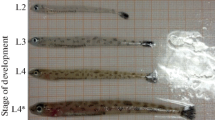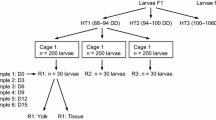Abstract
Larvae of the northern stone crab, Lithodes maja L., were reared in the laboratory from hatching to the second crab stage. complete larval development (at constant 9°C) lasted about 7 wk, invariably consisting of three pelagic zoeal stages and a semibenthic Megalopa; only two zoeal stages have been described in the literature. All larval stages are lecithotrophic. First feeding was consistently observed only after metamorphosis, in the first juvenile crab stage. In short intervals (every 1 to 5 d), developmental changes in biomass, B (expressed as: dry weight, W; carbon, C; nitrogen, N; hydrogen, H) and oxygen consumption (respiration, R) were measured in larvae and early juveniles; additionally, protein and carbohydrates were measured, but only in the zoeal stages and early Megalopa. Unusually high C contents (varying between 56 and 61% of W in eggs and freshly hatched Zoea I larvae from 12 different females) and high C:N weight ratios (8 to 11) indicate enhanced initial lipid stores, which are utilized as the major metabolic substrate during both embryonic and lecithotrophic larval development. Predominant degradation of lipids is shown indirectly; the C:N ratio decreased significantly, from 10 (at hatching) to 6 (at metamorphosis), while larval protein decreased only little, from ca. 55% of W (at hatching) to 48% (in the Megalopa). From hatching to metamorphosis, about 27% of the initially present W, 48% of C, 18% of N, and 52% of H were lost. This decrease in larval biomass can be described as an exponential function of development time. The major part of these losses were associated with metabolic energy requirements, while exuvial losses were comparably small. In each of the zoeal stages, only about 1 to 2% of late premoult (LPM) B was shed with the exuvia. The Megalopa, which produces a much thicker, calcified exoskeleton, lost 20% of LPM W, but only 5 to 8% of organic constituents (C, N, H). Much higher exuvial losses were measured in the Crab I stage (51% in W, 21% in C, 5% in N, and 7% in H). Maximum respiration was found in the actively swimming zoeal stages, a minimum in the predominantly benthic, mostly inactive Megalopa. The Crab I stage exhibits also a sluggish behaviour and low R, in spite of beginning food uptake and growth. Immediately after metamorphosis, the juvenile crab gained rapidly in W, in particular in its C fraction. A transitorily steep increase in the C:N ratio indicates a replenishment of partially depleted lipid stores, but also a rapid initial increase of inorganic C in the heavily calcified exoskeleton. Instantaneous rates of growth, assimilation, and net growth efficiency (K 2) were high during the initial (postmoult) phase in the first juvenile crab stage (C-specific growth rate: 6% d-1; K 2:70%), but decreased towards zero values during laterstages of the moulting cycle; metabolism remained practically constant during the Crab I stage. Entirely lecithotrophic larval development from hatching to metamorphosis in L. maja is considered an adaptation to seasonally short and limited planktonic food production in subarctic regions of the northern Atlantic.
Similar content being viewed by others
References
Anger K (1983) Temperature and the larval development of Hyas araneus L (Decapoda: Majidae); extrapolation of laboratory data to field conditions. J exp mar Biol Ecol 68: 203–215
Anger K (1986) Changes of respiration and biomass of spider crab (Hyas araneus) larvae during starvation. Mar Biol 90: 261–269
Anger K (1991) Developmental changes in the bioenergetics of decapod larvae. Mem Qd Mus 31: 289–308
Anger K (1995) The conquest of freshwater and land by marine crabs: adaptations in life-history patterns and larval bioenergetics. J exp mar Biol Ecol 193: 119–145
Anger K, Harms J (1990) Elemental (CHN) and proximate biochemical composition of decapod crustacean larvae. Comp Biochem Physiol 97B: 69–80
Anger K, Harms J, Christiansen ME, Süsens U, Wilmes B (1992) Growth patterns, chemical composition and oxygen consumption in early juvenile Hyas araneus (Decapoda: Majidae) reared in the laboratory. Helgoländer Meeresunters 46: 9–28
Anger K, Harms J, Püschel C, Seeger B (1989) Physiological and biochemical changes during the larval development of a brachyuran crab reared under constant conditions in the laboratory. Helgoländer Meeresunters 43: 225–244
Anger K, Schuh M (1992) Bioenergetics of abbreviated larval deveiopment in the bromelid crab, Metopaulias depressus (Decapoda: Grapsidae). Comp Biochem Physiol 103A: 507–518
Campodonico GI (1971) Desarrollo larval de la centolla Lithodes antarctica jacquinot en condiciones de laboratorio. (Crustácea Decapoda, Anomura: Lithodidae). An Inst Patagonia (Ser Ciencs nat) 2: 181–190
Campodonico GI, Guzmán L (1981) Larval development of Paralomis granulosa (Jacquinot) under laboratory conditions (Decapoda, Anomura, Lithodidae). Crustaceana 40: 272–285
Comoglio L, Vinuesa J (1991) Larval culture of southern king crab Lithodes santolla and false king crab Paralomis granulosa under laboratory conditions. In: Lavens P, Sorgeloos P, Jaspers E, Ollevier F (eds) Larvi '91. Symposium on Fish and Crustacean Larviculture. Eur Aquacult Soc, Spec Publ 15, Gent, Belgium, pp 349–350
Dawson EW (1989) King crabs of the world (Crustacea: Lithodidae) and their fisheries: a comprehensive bibliography. Misc Publ 101. New Zealand Oceanogr Inst, Div Water Sci, DSIR, Wellington
Dyer MF, Cranmer CJ, Fry P, Fry WG (1984) The distribution of benthic hydrographic indicator species in Svalbard water, 1978–1991. J mar biol Ass UK 64: 667–677
Ekman S (1953) Zoogeography of the sea. Sidgwick & Jackson, London
Gurney R (1942) Larvae of decapod Crustacea. Royal Society, London, pp 1–306
Harms J, Anger K, Klaus S, Seeger B (1991) Nutritional effects on ingestion rate, digestive enzyme activity, growth, and biochemical composition of Hyas araneus L. (Decapoda: Majidae) larvae. J exp mar Biol Ecol 145: 233–265
Haynes EB (1982) Description of larvae of the golden king crab, Lithodes aequispina, reared in the laboratory. Fish Bull US 80: 305–313
Haynes EB (1984) Early zoeal stages of Placetron wosnessenskii and Rhinolithodes wosnessenskii (Decapoda, Anomura, Lithodidae) and review of lithodid larvae of the northern North Pacific Ocean. Fish Bull US 82: 315–324
Holland DL, Gabbott PA (1971) A micro-analytical scheme for the determination of protein, carbohydrate, lipid and RNA levels in marine invertebrate larvae. J mar biol Ass UK 51: 659–668
Klages M, Gutt J, Starmans A, Bruns T (1995) Stone crabs close to the Antarctic continent: Lithodes murrayi Henderson, 1888 (Crustacea; Decapoda; Anomura) off Peter I Islands (68°C51′S, 90°51′W). Polar Biol 15: 73–75
Konishi K (1986) Larval development of the stone crab, Hapalogaster dentata (De Haan, 1844) (Crustacea: Anomura: Lithodidae) reared in the laboratory. J Fac Sci Hokkaido Univ (Ser 6) 24: 155–172
Kurata H (1960) Studies on the larva and post-larva of Paralithodes camtschatica. II. Feeding habits of the zoea. Bull Holkkaido reg Fish Res Lab 21: 1–8
Lombardo RJ, Ferrari L, Vinuesa JH (1991) Effects of lindane and acetone on the development of larvae of the southern king crab (Lithodes antarcticus Jaquinot). Bull envir Contam Toxic 46: 185–192
Lowry DH, Rosenberg NJ, Farr AL, Randall RJ (1951) Protein measurement with the folin phenol reagent. J biol Chem 193: 265–275
MacDonald JD, Pike RB, Williamson DI (1957) Larvae of the British species of Diogenes, Pagurus, Anapagurus and Lithodes (Crustacea, Decapoda). Proc zool Soc Lond 128: 209–257
Macpherson E (1991) Biogeography and community structure of the decapod crustacean fauna off Namibia (Southeast Atlantic). J Crustacean Biol 11: 401–415
Macpherson E (1994) Occurrence of two lithodid crabs (Crustacea: Decapoda: Lithodidae) in the cold seep zone of the South Barbados accretionary prism. Proc biol Soc Wash 107: 465–468
Markle DF, Dadswell MJ, Halliday RG (1987) Demersal fish and decapod crustacean fauna of the upper continental slope off Nova Scotia from La Have to St. Pierre Banks. Can J Zool 66: 1952–1960
Nakanishi T (1985) The effects of the environment on the survival rate, growth and respiration of eggs, larvae and post-larvae of king crab (Paralithodes camtschatica). In: Melteff BR (ed) Proc Int King Crab Symp, Lowell Wakefield Fisheries Symposium Series. Alaska Sea Grant Report 85-12, University of Alaska, Fairbanks, pp 167–185
Nakanishi T (1987) Rearing condition of eggs, larvae and postlarvae of king crab. Bull Japan Sea reg Fish Res Lab 37: 57–161
Nakanishi T, Naryu M (1981) Some aspects of large-scale rearing of larvae and post-larvae of the king crab (Paralithodes camtschatica). Bull Japan Sea reg Fish Res Lab 32: 39–47
O'Riordan CE (1986) Marine fauna notes from the National Museum of Ireland. Ir Nat J 22: 34–37
Paul AJ, Paul JM (1980) The effect of early starvation on later feeding success of king crab zoeae. J exp mar Biol Ecol 44: 247–251
Paul AJ, Paul JM, Shoemaker PA, Feder HM (1979) Prey concentrations and feeding response in laboratory-reared stage-one zoeae of king crab, snow crab, and pink shrimp. Trans Am Fish Soc 108: 440–443
Pike RB, Williamson DI (1958) Crustacea Decapoda: Larvae. XI. Paguridea, Coenobitidea, Dromiidea and Homolidea. Fich Ident Zooplancton 81: 1–9
Pike RB, Williamson DI (1959) Observations on the distribution and breeding of British hermit crabs and the stone crab (Crustacea: Diogenidae, Paguridae and Lithodidae). Proc zool Soc Lond 132: 551–567
Roff JC, Davidson KG, Pohle G, Dadswell MJ (1984) A guide to the marine flora and fauna of the Bay of Fundy and Scotian Shelf: larval Decapoda: Brachyura. Can tech Rep Fish aquat Sciences 1322: 1–57
Sachs L (1984) Angewandte Statistik, 6th edn. Springer Verlag, Berlin, Heidelberg, New York
Salonen K, Sarvala J, Hakala I, Viljanen ML (1976) The relation of energy and organic carbon in aquatic invertebrates. Limnol Oceanogr 21: 724–730
Sars GO (1889) Bidrag til Kundskaben om Decapodernes Forvandlinger. Arch Math Naturv 13: 133–201
Squires HJ (1990) Decapod Crustacea of the Atlantic coast of Canada. Can J Fish aquat Sciences 221: 1–532
Storch V, Anger K (1983) Influence of starvation and feeding on the hepatopancreas of larval Hyas araneus (Decapoda, Majidae). Helgoländer Meeresunters 36: 67–75
Thorson G (1946) Reproduction and larval development of Danish marine bottom invertebrates. Meddr Kommn Havunders (Ser Plankton) 4: 1–523
Vinuesa JH, Comoglio LI, Lovrich GA (1989) Growth of immature southern king crab, Lithodes santolla, in the Beagle Channel. In: Lowell Wakefield Fisheries Symposium, Proceedings of the International Symposium on King and Tanner Crabs, Anchorage, Alaska. University of Alaska Press, Anchorage, pp 259–271
Vinuesa JH, Ferrari L, Lombardo RJ (1985) Effect of temperature and salinity on larval development of southern king crab (Lithodes antarcticus). Mar Biol 85: 83–87
White A (1857) A popular history of British Crustacea; comprising a familiar account of their classification and habits. Lovell Reeve, London
Williams AB (1984) Shrimps, lobsters, and crabs of the Atlantic coast of the eastern United States, Maine to Florida. Smithsonian Institution Press, Washington, DC
Williams AB (1988) Notes on decapod and euphausiid crustaceans, continental margin, western Atlantic, Georges Bank to western Florida, USA. Fish Bull US 86: 67–76
Zöllner N, Kirsch K (1962) Über die quantitative Bestimmung von Lipoiden (Mikromethode) mittels der vielen natürlichen Lipoiden (allen bekannten Plasmalipoiden) gemeinsamen Sulfophosphovanillin-Reaktion. Z ges exp Med 135: 545–561
Author information
Authors and Affiliations
Additional information
Communicated by O. Kinne, Oldendorf/Luhe
Rights and permissions
About this article
Cite this article
Anger, K. Physiological and biochemical changes during lecithotrophic larval development and early juvenile growth in the northern stone crab, Lithodes maja (Decapoda: Anomura). Marine Biology 126, 283–296 (1996). https://doi.org/10.1007/BF00347453
Received:
Accepted:
Issue Date:
DOI: https://doi.org/10.1007/BF00347453




